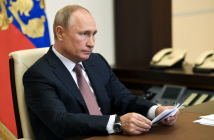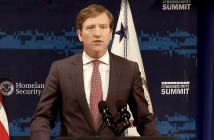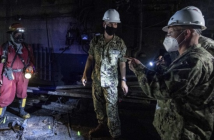Tom Garvey, Executive Vice President ,TT Electronics, discusses defense and international business as well as the company’s longterm plan for growth with Defense & Aerospace Report Editor Vago Muradian. The interview was conducted at the 2019 Paris airshow where our coverage was sponsored by Belle and Leonardo DRS.
Vago Muradian: Welcome to the Defense and Aerospace Report. I’m Vago Muradian here at the Paris Air Show at Le Bourget, just outside the French capital. One of the world’s truly great air shows, where our coverage here is sponsored by Bell and Leonardo DRS.
We’re over here in the British Pavilion on the TT Electronics stand to talk to Tom Garvey who is the Executive Vice President of the Power Electronics Division of the company.
Tom, we normally spend our time with a lot of the big contractors and actually don’t get to some of the smaller companies that actually are the heart of innovation across the aerospace and the defense sectors. You guys supply some of the biggest contractors in the world. So first tell us a little bit about sort of the history of the company and what you guys do that makes you such a key part of the entire ecosystem.
Tom Garvey: Sure. Thank you, Vago.
TT Electronics, our heritage has been in component manufacture serving some of the big names in airframes and engines, looking to the systems integrators and more and more providing them with hybrid microcircuits, electromagnetics and power modules, and of late in the last decade or so, we’ve built our engineering expertise investing in advanced technology centers, with universities and developing our engineering capability to provide value-added product solutions.
So we’ve mapped five layers of the supply chain, and we find at level three there’s a void and the systems integrators are having to do that work themselves because they don’t have a credible supply chain set up. So we’re looking at investment in technology but also looking to partners to invest with us to provide that competence and provide those LRU level capabilities. Things like auto transformer rectify units, power converters, motor controllers and serving U.S. defense contractors at the tier two level, the systems integrators, and providing the capability to do that. That’s kind of where we are.
Mr. Muradian: Everybody is positively stuck with how guys like you, because at the end of the day everybody wants to talk about sexy aerodynamics and everything else. But if you don’t have all of the other subordinate pieces of these increasingly electronic aircraft, that’s a problem. And for anybody who doesn’t know what an LRU is, it’s a line replaceable unit. They’re the cards and systems you can easily pull out on a flight line and quickly troubleshoot and get an airplane back flying.
You guys are a 5,000 person company which is a very big company, unless you compare it with the Lockheeds, the Boeings, and the Airbuses and the BAE Systems of the world. How do you guys stay competitive? Because in your position you have the primes jackhammer on the subs, the subs then jackhammer on you guys, and honestly, that’s got to give you a couple of sleepless nights as they’re making margin off of your head oftentimes.
Talk to us a little bit about how you guys stay competitive; how you guys manage to do the investment in a part of the market where the bigs just care about the product, so if you miss it by a little bit and there is some savings somewhere else, they may go for that.
Talk to us about how you stay competitive.
Mr. Garvey: I mentioned our component heritage because that’s really important. We’ve got some fantastic manufacturing facilities globally so they include Malaysia, they include the U.S., they include Europe and the UK, and those manufacturing facilities initially through the component heritage that we’ve got, we stay competitive by really making those efficient, automated, repeatable. So we’re at the right price to start with.
Then using that component heritage and the technology capability that we’ve built over that period and invested in and added, we’re then building value-added product solutions that allow us to provide better value solutions to our customers and they’re solutions that our customers, the system integrators in particular, have previously done in-house themselves. They’ve been very vertically integrated. We’re helping them with some of that non-core electrification. So replacing pneumatic hydraulic systems with electric systems on the more electric aircraft. We’re providing that expertise to take that piece on and allow those integrators to focus on what’s core to them and provide that credibility and expertise to do that. That for us is the long-term competitive solution, is really driving our products and or solutions to higher levels of technology.
Mr. Muradian: How many percents of your top line goes into R&D?
Mr. Garvey: About six percent of top-line goes into R&D at the moment. And that’s growing. We’re also heavily invested in, our most recent acquisitions are North American businesses with either defense or medical first lines, so we’ve grown our U.S. defense access.
Mr. Muradian: Let me ask you about that. You mentioned a little bit about tier three and where you guys want to play. Where are you guys going to be in five years? Because you guys have been growing. Again, you mentioned acquisition. Where do you guys want to be in five years?
Mr. Garvey: So UK [inaudible]at the moment, we’re 450 million market cut; by 2022 we intend to be a billion; we intend to be a [inaudible]250 company, and we’re growing through a mixture of organic growth. We’ve had some real good organic growth over the last two years, and that’s primarily due to the technology that we’re adding to the value-added product solutions. Focused on structural growth markets, air and space and defense absolutely key to us. Medical, key to us.
Mr. Muradian: Tom Garvey, Executive Vice President at TT Electronics’ Power Solutions business.
Sir, thanks very much. Best of luck. And I look forward to talking to you again, and I hope you have a great Paris Air Show.
Mr. Garvey: Appreciate it. Thank you, Vago.
30



